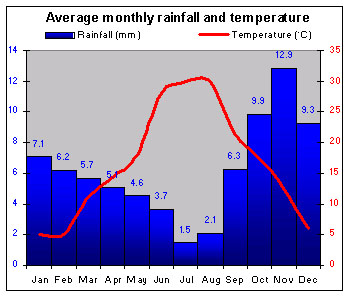COUNTRY INFORMATION |
Introduction |
The Vatican City lies close to the Tiber in central Rome and is the world's smallest independent state. It also includes ten other buildings in Rome and the pope's residence at Castel Gandolfo. As the Holy See it is the seat of the Roman Catholic Church, deriving its income from investments and voluntary contributions known as Peter's Pence. |
|
Climate |
 |
Winters are mild, though November is particularly gray, and summers are hot. |
|
People |
|
|
| URBAN/RURAL POPULATION DIVIDE |
|
|
|
The Vatican has about 500 citizens, including over 100 lay persons. Several hundred more lay staff are employed in the city state. Citizenship can be acquired through stable residence and holding an office or job within the City. A citizen's family can gain residence only by authorization. The pope is the spiritual leader of around 17% of the world's population. The countries with the largest number of Roman Catholics are Brazil, Mexico, Italy, the USA, and the Philippines. |
|
Economy |
| GNP (US$) |
Not applicable
|
M |
GNP World rank |
Not applicable
|
|
| Inflation |
No data |
% |
Unemployment |
No data |
% |
|
StrengthsIstituto per le Opere di Religione has assets of $3–$4 billion. Voluntary contributions from Catholics worldwide (Peter's Pence). Interest on investments. Gold reserves in Fort Knox, USA. Stamp and coin issues. Budgetary deficit of 23 years reversed to modest surplus in 1993. Receipts from tourists. WeaknessesLosses incurred by Radio Vaticana and L'Osservatore Romano, cost of foreign papal visits, buildings maintenance, and diplomatic missions. |
|
Politics |
| Lower house |
Last election |
No data |
Next election |
No data |
| Upper house |
Last election |
Not applicable |
Next election |
Not applicable |
|
The Vatican City operates in the manner of an elected monarchy, as the reigning pope has supreme executive, legislative, and judicial powers, and holds office for life. He is elected by the College of Cardinals, who vote until one candidate for the position of Supreme Pontiff achieves a two-thirds majority. The administration of the Vatican City State, of which the pope is temporal head, is conducted by the Pontifical Commission. The Holy See, which is the governing body of the Roman Catholic Church worldwide and of which the pope is spiritual head, is governed by the Roman Curia, the Church's administrative network. It is the Holy See that maintains diplomatic relations abroad. Pope John Paul II, elected in 1978, was the first non-Italian pope since 1523. Now in his 80s, he continues to fulfill his duties despite suffering from Parkinson's disease. |
|
Resources |
|
|
| Oil reserves (barrels) |
No data |
Oil production (barrels/day) |
Not an oil producer |
|
The Vatican imports all its energy. It has no farmland; its area is restricted to buildings and their formal gardens. |
|
Health |
| Life expectancy |
79 |
Life expect. World rank |
5 |
| Population per doctor |
Not applicable |
Infant mortality (per 1000 births) |
Not applicable |
|
|
|
| Principal causes of death |
Heart and cardiovascular diseases, cancers |
|
Pope John Paul II's strong opposition to abortion and contraception has prompted criticism from around the world, and from within the Church. |
|
Education |
| Literacy |
99 |
% |
Expend. % GNP |
No data |
%
|
|
| PERCENTAGE OF POPULATION IN FULL TIME EDUCATION |
|
| Primary |
No data |
% |
Secondary |
No data |
% |
Tertiary |
No data |
% |
|
The university, founded by Gregory XIII, is renowned for its theological and philosophical learning. There are more than 110,000 primary and secondary Catholic schools around the world. |
|
Wealth |
| Cars |
No data |
per 1,000 population |
| Telephones |
Not applicable |
per 1,000 population |
| Televisions |
Not applicable |
per 1,000 population |
|
The wealth of the Vatican is primarily that of the Church. Its art treasures may not be sold. It is not known how much personal wealth its citizens have.
|
History |
The Vatican is located in Rome because tradition held that St. Peter was buried on the site of the Church of Constantine, which was pulled down in the Renaissance to make way for the building of St. Peter's Basilica. The Vatican has been the pope's usual residence since 1417, when the pontiffs returned from Avignon in France at the end of the 39 years of Great Schism. - 1870 Italy annexes Papal States in central Italy.
- 1929 Lateran Treaty – Italy accepts Vatican City as independent state.
- 1978 Cardinal Karol Wojtyla pope.
- 1981–1982 Attempts on pope's life.
- 1984 Catholicism disestablished as Italian state religion.
- 1985 Catholic Catechism revised for first time since 1566.
- 1994–1995 Opposition to abortion and contraception reiterated at UN conferences in Cairo and Beijing.
- 1998 Statement repenting Catholic passivity during Nazi Holocaust.
- 2000 Jubilee Year. Papal apology for Catholic violence and oppression over two millennia.
- 2001 John Paul II becomes first pope to enter a mosque.
|
|